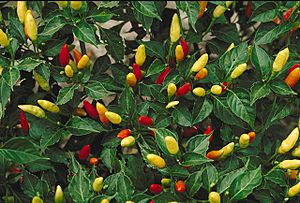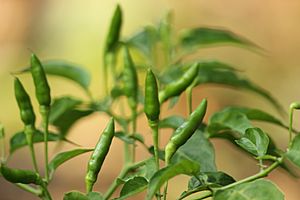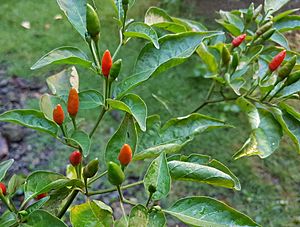Capsicum frutescens facts for kids
Quick facts for kids Capsicum frutescens |
|
|---|---|
 |
|
| Tabasco peppers | |
| Conservation status | |
| Scientific classification | |
| Genus: |
Capsicum
|
| Species: |
frutescens
|
Capsicum frutescens is a type of chili pepper that grows wild. It is closely related to the Capsicum chinense pepper, which people grow on farms. This pepper originally comes from Central America and South America.
Capsicum frutescens plants can live for one year (annual) or for a few years (perennial). Their flowers are usually white or light green. These flowers can be pollinated by insects or by themselves. The peppers, which are actually the plant's berries, usually grow pointing upwards. They are often small and very spicy. These peppers are typically about 10 to 20 millimeters long and 3 to 7 millimeters wide. They start as a pale yellow color and turn bright red when they are ripe. However, they can also ripen to other colors. Some types of C. frutescens are grown just because they look pretty, with many colorful peppers growing upright on the plant.
Contents
What Are Capsicum frutescens Peppers?
Capsicum frutescens is a species of chili pepper known for its small, often very spicy fruits. These peppers are found in many tropical and subtropical areas around the world. They are part of the Capsicum genus, which includes all types of peppers.
Different Types of Capsicum frutescens
There are many different kinds, or cultivars, of Capsicum frutescens peppers. Each type has its own special qualities. Here are some well-known ones:
- Wiri Wiri, from Guyana
- Cabai Rawit, from Indonesia, often used in a hot sauce called Sambal.
- Hawaiian pepper
- Malagueta pepper
- Piri piri, also known as African Bird's Eye or African Devil.
- Siling Labuyo, from the Philippines.
- Tabasco pepper, which is famous for making Tabasco sauce.
- Xiao mi la pepper, which means "little rice pepper," from China.
Where Do These Peppers Come From?
The Capsicum frutescens pepper likely first appeared in South America or Central America. From there, it quickly spread to other warm, tropical parts of the world. Even today, you can find these peppers growing wild in many places. They are especially common in Central America and the northern and western parts of South America. Scientists believe C. frutescens might be related to another pepper, Capsicum chinense.
How People Use Capsicum frutescens
These peppers are used in many ways around the world, especially in cooking.
Ethiopia's Love for Barbaré
In Ethiopia, C. frutescens is called barbaré. It has been a very important part of Ethiopian food for a long time, even back in the 1800s. People grew it in warm areas where the soil was good. While it was grown everywhere, it was especially common in a region called Yejju. This area supplied a lot of barbaré to other places, like Showa. One valley, the upper Golima River valley, was almost entirely covered with these pepper plants. Thousands of acres were used for growing barbaré, and it was harvested all year long.
Popular in India
This pepper is also very common in eastern and southern India. It grows easily there because the climate is perfect for it. People in India know it by many different local names.
What Makes Peppers Hot?

The hot feeling you get from eating chili peppers comes from a chemical called Capsaicin. This chemical is found in all spicy peppers, including Capsicum frutescens.
Pests That Eat Peppers
Most insects don't like eating spicy peppers because of the capsaicin. However, there is one insect called Helicoverpa assulta that can eat red peppers without being bothered by the heat. It's one of the few insects that can handle capsaicin.
Images for kids
See also
 In Spanish: Capsicum frutescens para niños
In Spanish: Capsicum frutescens para niños









